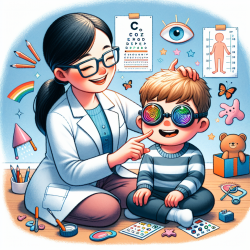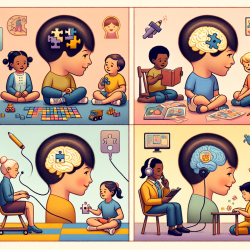In the realm of speech-language pathology and child development, understanding the nuanced needs of children with Autism Spectrum Disorder (ASD) is crucial. Recent research, particularly the study titled "Near-point Findings in Children with Autism Spectrum Disorder and in Typical Peers," sheds light on critical vision-related differences between children with ASD and their typically developing peers. This blog aims to provide practitioners with actionable insights from this study to enhance therapy outcomes for children with ASD.
Key Findings
The study conducted a comprehensive eye examination of 61 children aged 9 to 17, including 34 with ASD and 27 typically developing (TD) peers. Key findings include:
- Children with ASD exhibit significantly more exophoria at near distances compared to TD peers.
- Mean near point of convergence (NPC) break and recovery were significantly more receded in ASD subjects.
- ASD children showed poorer stereoacuity and reduced fixation, accuracy, and stamina in oculomotor testing.
Implications for Practitioners
Understanding these differences can inform tailored therapeutic strategies. Here are some recommendations:
1. Enhanced Screening and Diagnosis
Given the higher likelihood of vision issues in children with ASD, incorporating comprehensive binocular vision evaluations into regular assessments is essential. Early identification of vision problems can lead to timely interventions.
2. Individualized Therapy Plans
Therapy plans should account for the unique vision-related challenges faced by children with ASD. For instance:
- Use visual supports and minimize visual clutter to accommodate poor fixation and convergence.
- Incorporate breaks during tasks requiring sustained visual attention to manage visual fatigue.
3. Collaborative Care
Coordination with optometrists, occupational therapists, and educators is vital. Sharing findings from vision assessments can help create a holistic approach to the child's development.
4. Use of Assistive Technology
Leveraging technology that accommodates visual deficits can enhance learning and engagement. Tools like guided readers or apps that reduce visual strain can be beneficial.
Encouraging Further Research
While this study provides valuable insights, more research is needed to fully understand the implications of vision issues in children with ASD. Practitioners are encouraged to:
- Stay updated with the latest research to continuously refine therapeutic approaches.
- Consider participating in or supporting studies that explore the intersection of vision and ASD.
Conclusion
Integrating findings from the study "Near-point Findings in Children with Autism Spectrum Disorder and in Typical Peers" into practice can significantly improve therapy outcomes for children with ASD. By recognizing and addressing vision-related challenges, practitioners can create more effective, individualized therapy plans.To read the original research paper, please follow this
Near-point Findings in Children with Autism Spectrum Disorder and in Typical Peers.










